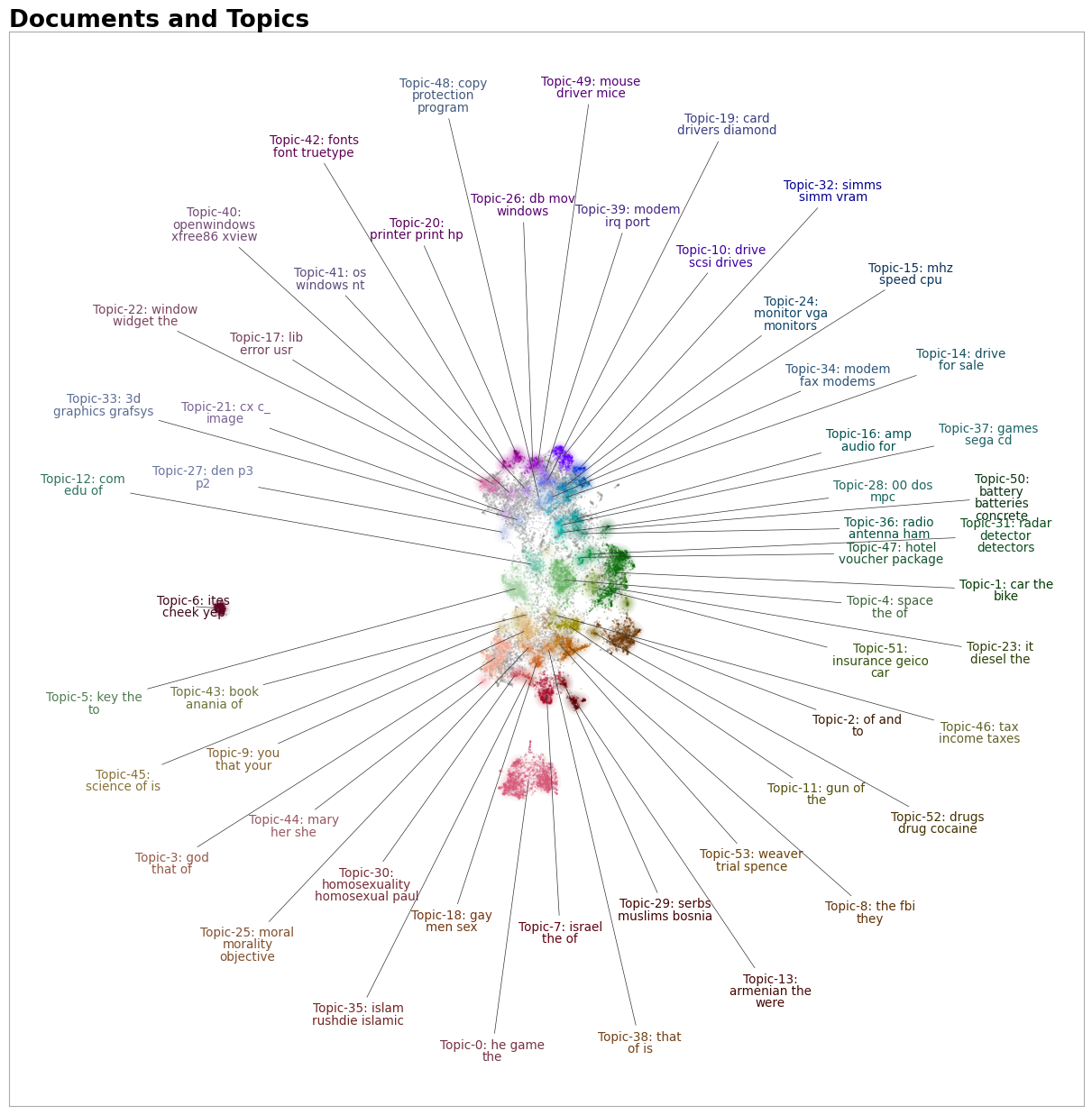Documents
Visualize documents with Plotly¶
Using the .visualize_topics, we can visualize the topics and get insight into their relationships. However,
you might want a more fine-grained approach where we can visualize the documents inside the topics to see
if they were assigned correctly or whether they make sense. To do so, we can use the topic_model.visualize_documents()
function. This function recalculates the document embeddings and reduces them to 2-dimensional space for easier visualization
purposes. This process can be quite expensive, so it is advised to adhere to the following pipeline:
from sklearn.datasets import fetch_20newsgroups
from sentence_transformers import SentenceTransformer
from bertopic import BERTopic
from umap import UMAP
# Prepare embeddings
docs = fetch_20newsgroups(subset='all', remove=('headers', 'footers', 'quotes'))['data']
sentence_model = SentenceTransformer("all-MiniLM-L6-v2")
embeddings = sentence_model.encode(docs, show_progress_bar=False)
# Train BERTopic
topic_model = BERTopic().fit(docs, embeddings)
# Run the visualization with the original embeddings
topic_model.visualize_documents(docs, embeddings=embeddings)
# Reduce dimensionality of embeddings, this step is optional but much faster to perform iteratively:
reduced_embeddings = UMAP(n_neighbors=10, n_components=2, min_dist=0.0, metric='cosine').fit_transform(embeddings)
topic_model.visualize_documents(docs, reduced_embeddings=reduced_embeddings)
Note
The visualization above was generated with the additional parameter hide_document_hover=True which disables the
option to hover over the individual points and see the content of the documents. This was done for demonstration purposes
as saving all those documents in the visualization can be quite expensive and result in large files. However,
it might be interesting to set hide_document_hover=False in order to hover over the points and see the content of the documents.
Custom Hover¶
When you visualize the documents, you might not always want to see the complete document over hover. Many documents have shorter information that might be more interesting to visualize, such as its title. To create the hover based on a documents' title instead of its content, you can simply pass a variable (titles) containing the title for each document:
topic_model.visualize_documents(titles, reduced_embeddings=reduced_embeddings)
Visualize documents with DataMapPlot¶
.visualize_document_datamap provides an alternative way to visualize the documents inside the topics as a static DataMapPlot. Using the same pipeline as above, you can generate a DataMapPlot by running:
# with the original embeddings
topic_model.visualize_document_datamap(docs, embeddings=embeddings)
# with the reduced embeddings
topic_model.visualize_document_datamap(docs, reduced_embeddings=reduced_embeddings)

Or if you want to save the resulting figure:
fig = topic_model.visualize_document_datamap(docs, reduced_embeddings=reduced_embeddings)
fig.savefig("path/to/file.png", bbox_inches="tight")
Interactive DataMapPlot¶
DataMapPlot has the amazing ability to also generate interactive plots. These plots generate HTML files that allow you zoom in on the generated topics and explore the data.
Usage is straightforward, simply set interactive=True:
fig = topic_model.visualize_document_datamap(docs, reduced_embeddings=reduced_embeddings, interactive=True)
Visualize Probabilities or Distribution¶
We can generate the topic-document probability matrix by simply setting calculate_probabilities=True if a HDBSCAN model is used:
from bertopic import BERTopic
topic_model = BERTopic(calculate_probabilities=True)
topics, probs = topic_model.fit_transform(docs)
The resulting probs variable contains the soft-clustering as done through HDBSCAN.
If a non-HDBSCAN model is used, we can estimate the topic distributions after training our model:
from bertopic import BERTopic
topic_model = BERTopic()
topics, _ = topic_model.fit_transform(docs)
topic_distr, _ = topic_model.approximate_distribution(docs, min_similarity=0)
Then, we either pass the probs or topic_distr variable to .visualize_distribution to visualize either the probability distributions or the topic distributions:
# To visualize the probabilities of topic assignment
topic_model.visualize_distribution(probs[0])
# To visualize the topic distributions in a document
topic_model.visualize_distribution(topic_distr[0])
Although a topic distribution is nice, we may want to see how each token contributes to a specific topic. To do so, we need to first calculate topic distributions on a token level and then visualize the results:
# Calculate the topic distributions on a token-level
topic_distr, topic_token_distr = topic_model.approximate_distribution(docs, calculate_tokens=True)
# Visualize the token-level distributions
df = topic_model.visualize_approximate_distribution(docs[1], topic_token_distr[1])
df

Note
To get the stylized dataframe for .visualize_approximate_distribution you will need to have Jinja installed. If you do not have this installed, an unstylized dataframe will be returned instead. You can install Jinja via pip install jinja2
Note
The distribution of the probabilities does not give an indication to the distribution of the frequencies of topics across a document. It merely shows how confident BERTopic is that certain topics can be found in a document.